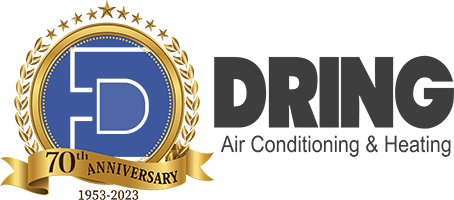Americans spend more than 90% of their time indoors, and poor indoor air quality is a growing concern. In fact, the EPA has elevated indoor air pollution to one of the top health risks facing the country and warns that modern construction techniques have only exacerbated the problem due to the tight residential building envelopes that are now possible. Winter is a particularly concerning season for indoor air quality because homes are sealed shut and heating systems are often running for long periods.
Schedule a Seasonal HVAC Tune-Up
Your heating system blows warmed air throughout your home, which certainly makes it comfortable but can also have the unfortunate side effect of undermining your indoor air quality through the distribution of dust and other contaminants. The HVAC industry recommendation is to schedule a tune-up in autumn prior to needing to run your heating system. Doing so will extend the life of your equipment and lower your monthly energy bill. It will also help with air quality as your technician will clean all of the equipment to remove dust and grime accumulation and swap in clean air filters. It is also a good idea to have your HVAC technician assess your home ventilation system during this appointment, as it is even more important during winter when natural ventilation tends to be minimized.
Schedule Duct Cleaning
While you don’t have to schedule duct cleaning every year, your seasonal appointment is a good time to do it if your home is due. The general industry recommendation is to clean your ducts every three years, but you may need to adjust that period based on your household. Dog and cat owners, for instance, often need their ducts cleaned on a more frequent basis. Dust is a fact of life and unavoidable in forced-air systems. As air travels through your ductwork, dust will settle in the ducts due to the static pressure. This dust is just like other dust throughout your home but is not easily reached by you and will accumulate into a thick layer over time. Your HVAC company will use a camera system and a long vacuum to suck all of that particulate matter out of the duct network.
Win the Battle Against Dust
Dust is a much bigger concern than many homeowners realize. It is made up of skin cells, hair, dander, soil particles, dust mites, dead bugs and many other disgusting items. If that isn’t bad enough, dust is effectively a sponge that collects pollutants in the home. Once trapped in that amalgamation, the life span of the pollution is extended, and the dust continues to remit the harmful gases over time. This is the reason that regular duct cleaning is so important. You also need to win the battle against the dust that you can reach. The EPA recommends an extensive dusting of your home no less than once a week. Dust all rooms from top to bottom using a microfiber duster, and finally, vacuum the room using a HEPA filter bag in order to avoid redispersing the dust.
Humidify Your Home
Air is drier in winter because the temperature is colder, so the air holds less moisture. Very dry air in a home is a typical byproduct of heating it as you’re constantly introducing dry air and never replenishing the moisture, which requires a humidifier. Humidifying your home has a number of benefits. Maintaining an ideal relative humidity means you’ll be warmer at a lower temperature. You can turn the thermostat down and save on heating costs and equipment wear. Running a humidifier will also eliminate the respiratory inflammation, headaches and fatigue often associated with dry air. A portable humidifier that you can bring with you from room to room is an effective local option, but you’ll need a whole-home humidification system to reap the full benefits throughout the residence.
Eliminate Unintentional Pollutants and Contaminants
Many homeowners unintentionally pollute their homes with the products that they bring into them, and this is particularly concerning during winter when ventilation is at a premium. Pay attention to the cleaners you purchase. Opt for organic alternatives whenever possible, and when not, store those products in a garage or shed instead of under a sink or in a pantry. Be careful with houseplants as well. Even slight overwatering can negatively affect air quality due to mold growth, so be careful with watering and perhaps choose plants that need little water, such as a jade plant or sago palm.
Install a Mechanical Ventilation System
Mechanical ventilation systems are becoming increasingly popular in homes due to the tight building seals that are now possible. If your home doesn’t have one, you may want to consider it, as it will give you much greater control over introducing fresh air into the home. There are also additional benefits if you choose an energy recovery ventilator (ERV) or similar technology. An ERV captures energy that would otherwise be lost and thus improves energy efficiency and can help with humidification as well.
Enhance Your Home Air With Air Purification
An important point concerning air pollution is that the air inside your home can never be cleaner than the air outside of it without some form of filtration. HVAC air filters do not count as they’re designed to keep dust out of the system as opposed to clean the air. You’ll need a dedicated air filter or an air purifier with multiple components. A medical-grade HEPA air filter is an excellent choice for eliminating the particulate matter in your home, but particles aren’t the only concern. You may want activated carbon, for instance, to deal with gases and odors and ultraviolet light to kill viruses and bacteria.
Monitor Your Indoor Air Quality
If you have never had the air quality in your home tested, you may want to schedule that service in order to have a detailed view of what your problem areas are. You should also have a means of monitoring your indoor air quality on an ongoing basis. There are many smart thermostats on the market that provide these features. Smart thermostats help you minimize your heating and cooling costs but also monitor relative humidity, particular matter, volatile organic compounds and carbon monoxide, among other things.
Test Your Home for Radon
Radon is the number one cause of lung cancer among non-smokers in the U.S. The only way to know if radon is seeping up from the earth into your home is to test for it. In addition, it is recommended that you re-test every two years as radon can emerge as a problem in a home that was previously radon free.
Your Local Indoor Air Quality Experts in Carrollton
Dring Air Conditioning & Heating has served Carrollton and the surrounding areas since 1953. That means that our HVAC company has nearly 70 years of experience helping area homeowners achieve and maintain optimal indoor air quality. Our team also installs, services, and repairs all manner of heating and cooling technologies used in homes in this region, including furnaces, central air conditioning systems, heat pumps and ductless mini splits. Call Dring Air Conditioning & Heating today or contact us online if you have any questions about our products or services or would like to schedule an appointment.







